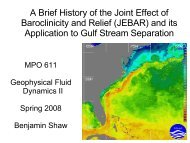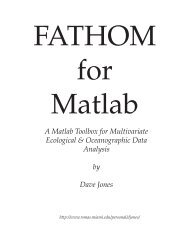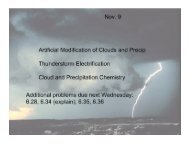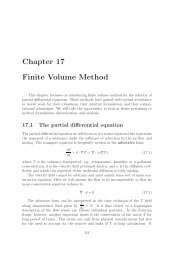2007 (PDF) - Rosenstiel School of Marine and Atmospheric Science ...
2007 (PDF) - Rosenstiel School of Marine and Atmospheric Science ...
2007 (PDF) - Rosenstiel School of Marine and Atmospheric Science ...
You also want an ePaper? Increase the reach of your titles
YUMPU automatically turns print PDFs into web optimized ePapers that Google loves.
Pew Institute for Ocean <strong>Science</strong><br />
<strong>2007</strong> <strong>Rosenstiel</strong> Award<br />
Conserving Our Oceans<br />
The Pew Institute for Ocean <strong>Science</strong> (PIOS) in <strong>2007</strong> conducted<br />
<strong>and</strong> sponsored pioneering research worldwide to conserve oceans<br />
<strong>and</strong> protect marine life, <strong>and</strong> reduce human impacts upon them.<br />
PIOS is headed by Executive Director Ellen Pikitch, Ph.D., who<br />
is also pr<strong>of</strong>essor <strong>of</strong> <strong>Marine</strong> Biology <strong>and</strong> Fisheries at the <strong>Rosenstiel</strong><br />
<strong>School</strong>. The Institute created important new knowledge this year<br />
about sharks, coral reefs, sturgeon <strong>and</strong> ocean ecosystems.<br />
Pew Institute Executive Director Dr. Ellen Pikitch <strong>and</strong><br />
research scientist Dr. Daniel Erickson tagging an Atlantic<br />
sturgeon on the Hudson River to track its movement patterns.<br />
Photo credit: PIOS<br />
PIOS sponsored<br />
research that uncovered,<br />
through<br />
DNA testing,<br />
that endangered<br />
basking sharks<br />
are still being<br />
wastefully<br />
killed for their<br />
high-priced fins<br />
for use in soup<br />
in Japan, Hong<br />
Kong, <strong>and</strong><br />
even the United<br />
States, despite<br />
an international<br />
trade ban.<br />
Documenting the first “Virgin Birth” <strong>of</strong> a shark – named by <strong>Science</strong><br />
News as one <strong>of</strong> the year’s top science stories –the team identified a<br />
possible evolutionary adaptation to a shrinking male hammerhead<br />
shark population. The team also continued its eight-year Glover’s<br />
Reef Shark Survey in Belize, tagging <strong>and</strong> tracking Caribbean reef<br />
sharks <strong>and</strong> amassing scientific data needed to conserve local populations<br />
<strong>and</strong> protect reef sharks worldwide.<br />
The Pew Institute supported the work <strong>of</strong> external scientists who<br />
uncovered far-reaching implications <strong>of</strong> ocean food web disruptions.<br />
Their research published in <strong>Science</strong>, for example, found that a shellfish<br />
shortage along the U.S. Atlantic coast was caused by depletion<br />
<strong>of</strong> predatory sharks, whose favorite food<br />
(rays <strong>and</strong> skates) multiplied dramatically<br />
<strong>and</strong> gorged on bay scallops.<br />
Additionally, sturgeon experts from the<br />
Pew Institute took steps to protect this<br />
ancient fish, which is on the brink <strong>of</strong><br />
extinction due to the incessant pursuit<br />
<strong>of</strong> its caviar eggs. Scientists tagged <strong>and</strong><br />
tracked threatened sturgeon species into Kazakhstan’s Caspian Sea,<br />
<strong>and</strong> closer to home into New York’s Hudson <strong>and</strong> Oregon’s Rogue<br />
Rivers, to better underst<strong>and</strong> migratory behavior <strong>and</strong> spawning<br />
habitats. PIOS also collaborated with American Museum <strong>of</strong> Natural<br />
History geneticists to detect, through DNA analysis <strong>of</strong> storebought<br />
caviar, whether beluga caviar continues to be sold in the<br />
United States despite an importation ban.<br />
The year also marked the beginning <strong>of</strong> an exciting partnership with<br />
Chantecaille cosmetics, which designed a collector’s edition compact<br />
with a beautiful faux-coral cover (photo below) <strong>and</strong> donated<br />
five percent <strong>of</strong> the proceeds to the “Reefs <strong>of</strong> Hope” project. The<br />
funds will help PIOS scientists<br />
to uncover whether certain<br />
coral species can adapt to survive<br />
climate change, <strong>and</strong> apply that<br />
knowledge to protecting other<br />
corals.<br />
Throughout the year, more than<br />
100 Pew Fellows in <strong>Marine</strong><br />
Conservation representing 27<br />
countries, continued to pursue conservation solutions through<br />
research, education, advocacy, <strong>and</strong> community-based projects. Five<br />
new Pew Fellows from Australia, Japan <strong>and</strong> the United States were<br />
selected to address critical challenges to healthy oceans, including<br />
climate change <strong>and</strong> ecosystem mismanagement. These scientists<br />
joined over 100 Fellows <strong>and</strong> guests at an annual gathering in Morro<br />
Bay, California to share ideas that can lead to increasingly effective<br />
conservation solutions.<br />
Of Ice <strong>and</strong> Men<br />
On the tropical isl<strong>and</strong> <strong>of</strong> Oahu, Hawaii, amidst active volcanoes<br />
<strong>and</strong> easterly trade winds, Dr. Axel Timmermann, an associate<br />
pr<strong>of</strong>essor <strong>of</strong> Oceanography at the University <strong>of</strong> Hawaii, Manoa,<br />
cannot stop thinking about ice. Thous<strong>and</strong>s <strong>of</strong> years ago during the<br />
last ice age, the global climate shifted suddenly from cold to warm,<br />
<strong>and</strong> then in only a<br />
century, swung back<br />
to a glacial state. For<br />
Timmermann, finding<br />
out why abrupt<br />
climate variations<br />
occurred in the past<br />
<strong>of</strong>fers the chance to<br />
step back hundreds <strong>of</strong><br />
thous<strong>and</strong>s <strong>of</strong> years at<br />
a time, to uncover the<br />
answers to important<br />
questions surrounding<br />
modern climate<br />
dynamics.<br />
Dr. Axel Timmermann in Kalaupapa on Molokai<br />
carrying a “portable” CTD to analyze the temperature<br />
<strong>and</strong> salinity structure <strong>of</strong> the 4th deepest lake in<br />
the US. Photo credit: Niklas Schneider.<br />
For his dedication<br />
<strong>and</strong> substantial<br />
contributions to<br />
marine oceanographic<br />
research, Timmermann<br />
was selected by the<br />
Division <strong>of</strong> Meteorology<br />
<strong>and</strong> Physical Oceanography to receive the prestigious <strong>2007</strong><br />
<strong>Rosenstiel</strong> Award for Outst<strong>and</strong>ing Achievement <strong>and</strong> Distinction in<br />
Oceanographic <strong>Science</strong>. The <strong>Rosenstiel</strong> Award is designed to honor<br />
scientists who have made significant <strong>and</strong> growing impacts in their<br />
field in the last decade.<br />
Timmermann is highly regarded for his seminal modeling study,<br />
which predicts increased El Niño Southern Oscillation frequency<br />
in response to future greenhouse warming. His work is widely cited<br />
<strong>and</strong> part <strong>of</strong> a large catalog <strong>of</strong> published works that seek to underst<strong>and</strong><br />
the fundamental mechanisms driving El Niño in the past,<br />
present <strong>and</strong> future. Timmermann’s more recent work has revealed<br />
mechanisms that link climate variability in the Pacific Ocean with<br />
the Atlantic Ocean, on decadal <strong>and</strong> longer timescales. His theories<br />
have contributed to a modern, integrated view <strong>of</strong> the global climate<br />
system.<br />
Co-author <strong>of</strong> three chapters <strong>of</strong> the 2001 Intergovernmental Panel on<br />
Climate Change (IPCC) 3rd Assessment Report, Timmermann currently<br />
chairs the International Pacific CLIVAR (Climate Variability<br />
<strong>and</strong> Predictability) Panel.<br />
In <strong>2007</strong>, together with Dr. Lowell Stott from the University <strong>of</strong><br />
Southern California, he published a groundbreaking paper in<br />
<strong>Science</strong> that proposes a new forcing mechanism for the southern<br />
hemispheric deglacial temperature rise: an increase in orbitally-induced<br />
spring insolation starting around 19,000 years ago. According<br />
to the team’s coupled climate model, this event led to a massive<br />
reduction in spring <strong>and</strong> summer sea-ice extent around Antarctica,<br />
which had repercussions for not only the southern hemisphere,<br />
but also potentially for the oceanic release <strong>of</strong> carbon dioxide. This<br />
explanation is at odds with previous ideas on deglacial temperature<br />
rise in the southern hemisphere that invoked northern hemispheric<br />
forcing.<br />
Timmermann, who is currently the research team leader at the<br />
International Pacific Research Center <strong>of</strong> the <strong>School</strong> <strong>of</strong> Ocean<br />
<strong>and</strong> Earth <strong>Science</strong> <strong>and</strong> Technology at the University <strong>of</strong> Hawaii at<br />
Manoa, is studying the Paleocene Eocene Thermal Maximum, a<br />
period <strong>of</strong> global warming 55 million years ago that marks one <strong>of</strong><br />
the most fascinating climate changes in the planet’s history. He is<br />
also working to obtain funding for fieldwork on Lake Kauhako,<br />
the 4th deepest lake in the United States. The ultimate goal <strong>of</strong> the<br />
project is to retrieve a sediment core from this anoxic lake in order<br />
to reconstruct the history <strong>of</strong> climate, vegetation, mega-tsunamis<br />
<strong>and</strong> volcanic eruptions for the Hawaiian Isl<strong>and</strong>s, which will help<br />
explain environmental changes the Hawaiian Isl<strong>and</strong>s may have<br />
experienced before the arrival <strong>of</strong> humans.<br />
Little Salt Spring: Plunging into the Past<br />
Listed in the National Register <strong>of</strong> Historic Places, Little Salt Spring is a unique underwater archaeological site, providing unparalleled<br />
evidence <strong>of</strong> human activity in the New World from at least 12,000 years ago, <strong>and</strong> an environment that has helped preserve to present<br />
day the most fragile traces <strong>of</strong> human activities, dating back to the end <strong>of</strong> the last Ice Age.<br />
What makes the Little Salt Spring Archaeological <strong>and</strong> Ecological Preserve truly unique is the lack <strong>of</strong> dissolved oxygen in the water,<br />
which has essentially preserved artifacts from the earliest New World cultures, keeping even organic materials from deteriorating.<br />
Located in Sarasota County, Florida, this geological phenomenon known as a karst sinkhole slowly developed over thous<strong>and</strong>s <strong>of</strong> years,<br />
penetrating the limestone bedrock to ultimately produce a more-than-200-foot-deep, hourglass-shaped spring that is fed from an<br />
underground water source.<br />
The University <strong>of</strong> Miami owns the 110-acre preserve that includes the spring in which researchers have unearthed hundreds <strong>of</strong> artifacts.<br />
A natural ledge at 90 feet below the spring’s surface became an important resting spot for organic artifacts – wood, bone, antler <strong>and</strong><br />
plant fiber – that researchers have excavated <strong>and</strong> carbon dated to the Paleo Indian period- the earliest <strong>of</strong> North American habitation.<br />
In 1986, researchers recovered human tissue almost 7,000 years old from other parts<br />
<strong>of</strong> the spring, dating to the Middle Archaic period. In amplifying <strong>and</strong> sequencing<br />
fragments <strong>of</strong> mitochondrial DNA, they discovered a genetic lineage not previously<br />
recognized in New World populations.<br />
Limited funding has kept infrastructure <strong>and</strong> facilities on the site rudimentary. With 95<br />
percent <strong>of</strong> the spring yet to be explored, the potential this site <strong>of</strong>fers for underwater<br />
archaeologists such as Dr. John Gifford, Little Salt Spring Principal Investigator <strong>and</strong><br />
Associate Pr<strong>of</strong>essor at the <strong>Rosenstiel</strong> <strong>School</strong>, is unparalleled. The University <strong>of</strong> Miami<br />
is now in a position to <strong>of</strong>fer some <strong>of</strong> the most important research <strong>and</strong> educational opportunities<br />
to its students, faculty <strong>and</strong> guest researchers, who will have the potential<br />
to make a major impact on our underst<strong>and</strong>ing <strong>of</strong> the initial colonization <strong>of</strong> the New<br />
World.<br />
Little Salt Spring located in North Port, Florida.<br />
Photo credit: Barbra Gonzalez<br />
21 22


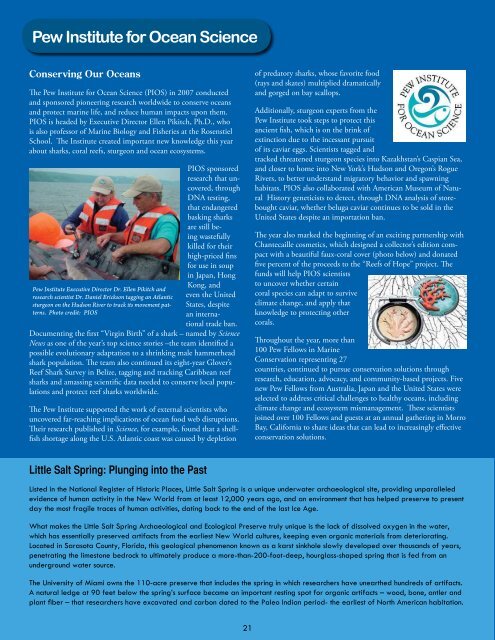

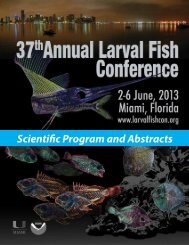
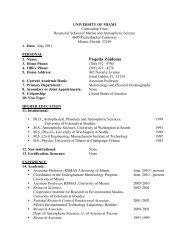
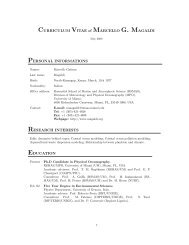
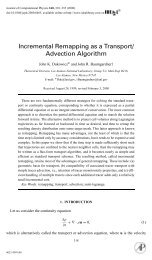
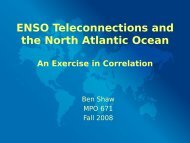
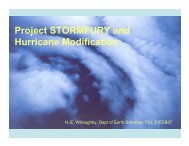
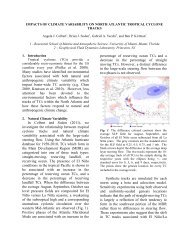
![Wavelength [μm] ZENITH ATMOSPHERIC TRANSMITTANCE](https://img.yumpu.com/26864082/1/190x143/wavelength-i-1-4-m-zenith-atmospheric-transmittance.jpg?quality=85)

